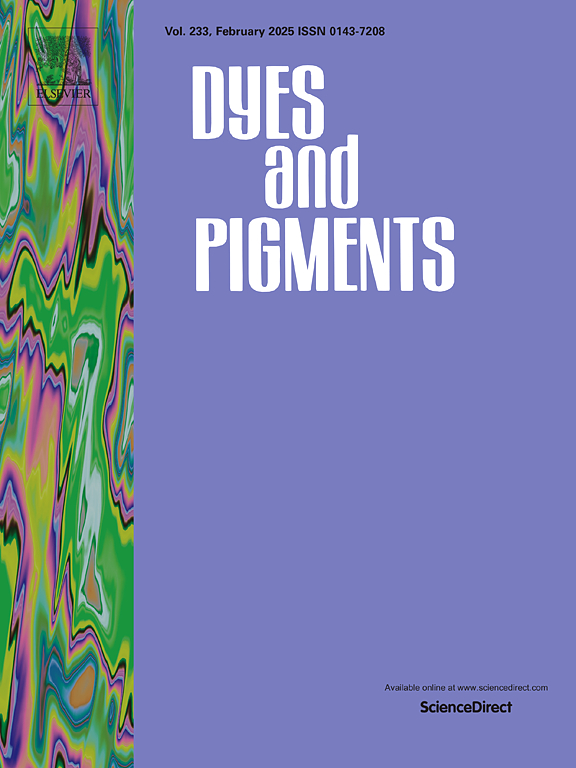Bis-benzimidazole-linked divinylcarbazoles as AIE-gens: Fluorescence turn-on response detecting polyamine vapors at diverse concentrations
IF 4.2
3区 工程技术
Q2 CHEMISTRY, APPLIED
引用次数: 0
Abstract
Benzimidazole (BIZ) is a pharmaceutically vital bicyclic heterocycle, recognized for exhibiting fascinating photophysical features. This work introduces a new class of AIEgens where BIZ rings hang against the divinylcarbazole central core and hold a conformationally twisted molecular structure. These molecules are almost non-emissive in the solid state. The molecular film coated on the coverslip displays a visually detectable turn-on fluorescence response upon selective exposure to polyamine (PA) vapor that gradually reacts and results in different emission profiles upon increasing vapor concentration starting from 2 mg/L. Detailed photophysical and mechanistic studies specify the aza-Michael addition and subsequent reverse Knoevenagel reactions between the PAs with the BIZ-linked divinylcarbazole. All the products are identified through LC-MS, and the produced imine plays a vital role in fluorescence intensity enhancement due to its crystallization-induced enhanced emission. Powder X-ray diffraction studies validated the improvement in crystallinity. Thus, these molecules could easily detect industrially and biologically vital PAs that can bring severe dangers to human health. Such an easily accessible platform can be used to detect the freshness of protein-rich food items such as fish and chicken.

双苯并咪唑连接的二乙烯基咔唑作为ae -gens:荧光开启响应检测不同浓度的多胺蒸气
苯并咪唑(BIZ)是一种重要的双环杂环,以其独特的光物理特性而闻名。这项工作介绍了一类新的AIEgens,其中BIZ环悬挂在二乙烯基咔唑中心核上,并保持构象扭曲的分子结构。这些分子在固态时几乎是不发光的。覆盖在盖盖上的分子膜在选择性暴露于多胺(PA)蒸气时显示出可视觉检测的开启荧光响应,该荧光响应逐渐发生反应,并在蒸气浓度从2 mg/L开始增加时产生不同的发射曲线。详细的光物理和机理研究确定了aza-Michael加成和随后的pa与bi连接的二乙烯基咔唑之间的逆Knoevenagel反应。所有产物都通过LC-MS进行了鉴定,所产生的亚胺由于其结晶诱导的增强发射,对荧光强度的增强起着至关重要的作用。粉末x射线衍射研究证实了结晶度的改善。因此,这些分子可以很容易地检测到工业上和生物学上至关重要的pa,这些pa可以给人类健康带来严重的危害。这样一个易于使用的平台可以用来检测富含蛋白质的食物的新鲜度,如鱼和鸡肉。
本文章由计算机程序翻译,如有差异,请以英文原文为准。
求助全文
约1分钟内获得全文
求助全文
来源期刊

Dyes and Pigments
工程技术-材料科学:纺织
CiteScore
8.20
自引率
13.30%
发文量
933
审稿时长
33 days
期刊介绍:
Dyes and Pigments covers the scientific and technical aspects of the chemistry and physics of dyes, pigments and their intermediates. Emphasis is placed on the properties of the colouring matters themselves rather than on their applications or the system in which they may be applied.
Thus the journal accepts research and review papers on the synthesis of dyes, pigments and intermediates, their physical or chemical properties, e.g. spectroscopic, surface, solution or solid state characteristics, the physical aspects of their preparation, e.g. precipitation, nucleation and growth, crystal formation, liquid crystalline characteristics, their photochemical, ecological or biological properties and the relationship between colour and chemical constitution. However, papers are considered which deal with the more fundamental aspects of colourant application and of the interactions of colourants with substrates or media.
The journal will interest a wide variety of workers in a range of disciplines whose work involves dyes, pigments and their intermediates, and provides a platform for investigators with common interests but diverse fields of activity such as cosmetics, reprographics, dye and pigment synthesis, medical research, polymers, etc.
 求助内容:
求助内容: 应助结果提醒方式:
应助结果提醒方式:


